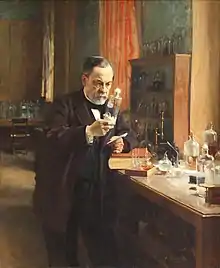Bacteriology
Bacteriology is the branch and specialty of biology that studies the morphology, ecology, genetics and biochemistry of bacteria as well as many other aspects related to them. This subdivision of microbiology involves the identification, classification, and characterization of bacterial species.[1] Because of the similarity of thinking and working with microorganisms other than bacteria, such as protozoa, fungi, and viruses, there has been a tendency for the field of bacteriology to extend as microbiology.[2] The terms were formerly often used interchangeably.[3] However, bacteriology can be classified as a distinct science.

Introduction
Bacteriology is the study of bacteria and their relation to medicine. Bacteriology evolved from physicians needing to apply the germ theory to test the concerns relating to the spoilage of foods and wines in the 19th century. Identification and characterizing of bacteria being associated to diseases led to advances in pathogenic bacteriology. Koch's postulates played a role into identifying the relationships between bacteria and specific diseases. Since then, bacteriology has had many successful advances like effective vaccines, for example, diphtheria toxoid and tetanus toxoid. There have also been some vaccines that were not as effective and have side effects for example, typhoid vaccine. Bacteriology has also provided discovery of antibiotics.
Bacteriologists
A bacteriologist is a microbiologist or a professional[4] trained in bacteriology. The duties of a bacteriologist primarily include prevention, diagnosis and prognosis of diseases. Alongside health care, they may carry out various functions such as epidemiological surveillance, quality auditing with biotechnology development, basic research, management and teaching related to the career, scientist management, laboratory coordination and blood banks.[5]
History
._Natuurkundige_te_Delft_Rijksmuseum_SK-A-957.jpeg.webp)


Bacteria were first observed by the Dutch microscopist Antonie van Leeuwenhoek in 1676, using a single-lens microscope of his own design. He then published his observations in a series of letters to the Royal Society of London.[6] His observations had also included protozoans which he called animalcules.[7]
Christian Gottfried Ehrenberg introduced the word "bacterium" in 1828.[8] In fact, his Bacterium was a genus that contained non-spore-forming rod-shaped bacteria,[9] as opposed to Bacillus, a genus of spore-forming rod-shaped bacteria defined by Ehrenberg in 1835.[10]
Louis Pasteur demonstrated in 1859 that the growth of microorganisms causes the fermentation process, and that this growth is not due to spontaneous generation (yeasts and molds, commonly associated with fermentation, are not bacteria, but rather fungi). Along with his contemporary Robert Koch, Pasteur was an early advocate of the germ theory of disease.[11] Before them, Ignaz Semmelweis and Joseph Lister had realised the importance of sanitized hands in medical work. Semmelweis' ideas were rejected and his book on the topic condemned by the medical community, but after Lister doctors started sanitizing their hands in the 1870s. While Semmelweis who started with rules about handwashing in his hospital in the 1840s predated the spread of the ideas about germs themselves and attributed diseases to "decomposing animal organic matter", Lister was active later.[12]
The discovery of the connection of microorganisms to disease can be dated back to the nineteenth century, when German physician Robert Koch introduced the science of microorganisms to the medical field.[13] He identified bacteria as the cause of infectious diseases and process of fermentation in diseases.[14][15][16] Koch, a pioneer in medical microbiology, worked on cholera, anthrax and tuberculosis. In his research into tuberculosis Koch finally proved the germ theory, for which he received a Nobel Prize in 1905.[17] In Koch's postulates, he set out criteria to test if an organism is the cause of a disease, and these postulates are still used today.[18] Louis Pasteur developed techniques to produce vaccines. Both Koch and Pasteur played a role in improving antisepsis in medical treatment. This had an enormous positive effect on public health and gave a better understanding of the body and diseases. In 1870-1885 the modern methods of bacteriology technique were introduced by the use of stains and by the method of separating mixtures of organisms on plates of nutrient media. Between 1880 and 1881 Pasteur produced two successful vaccinations for animals against diseases caused by bacteria and it was successful. The importance of bacteria was recognized as it led to a study of disease prevention and treatment of diseases by vaccines.[14][15][16]
Ferdinand Cohn is said to be a founder of bacteriology, studying bacteria from 1870. Cohn was the first to classify bacteria based on their morphology.[19][20]
Though it was known in the nineteenth century that bacteria are the cause of many diseases, no effective antibacterial treatments were available.[21] In 1910, Paul Ehrlich developed the first antibiotic, by changing dyes that selectively stained Treponema pallidum—the spirochaete that causes syphilis—into compounds that selectively killed the pathogen.[22] Ehrlich had been awarded a 1908 Nobel Prize for his work on immunology, and pioneered the use of stains to detect and identify bacteria, with his work being the basis of the Gram stain and the Ziehl–Neelsen stain.[23]
A major step forward in the study of bacteria came in 1977 when Carl Woese recognised that archaea have a separate line of evolutionary descent from bacteria.[24] This new phylogenetic taxonomy depended on the sequencing of 16S ribosomal RNA, and divided prokaryotes into two evolutionary domains, as part of the three-domain system.[25] Bacteriology has developed and can be studied in agriculture, marine biology, water pollution, bacterial genetics and biotechnology.[14][15][16]
See also
- Bacterial phylodynamics, the study of immunology, epidemiology, and phylogenetics of bacterial pathogens to better understand the evolutionary role of these pathogens
References
- Wassenaar, T. M. "Bacteriology: the study of bacteria". www.mmgc.eu. Archived from the original on 24 July 2011. Retrieved 18 June 2011.
- MacNeal, Ward J.; Williams, Herbert Upham (1914). Pathogenic micro-organisms; a text-book of microbiology for physicians and students of medicine. P. Blakiston's Sons. pp. 1–. Retrieved 18 June 2011.
- Poindexter, Jeanne Stove (30 November 1986). Methods and special applications in bacterial ecology. Springer. p. 87. ISBN 978-0-306-42346-8. Retrieved 18 June 2011.
- "Bacteriologist: Job Description, Duties and Salary". Study.com. Retrieved 2017-04-03.
- "Act 841 of 2003" (PDF). By which the exercise of the profession is regulated bacteriologist, // the code of bioethics and other provisions are issued (in Spanish). Ministry of Education. Retrieved 15 May 2014.
- Wheelis 2008.
- Pommerville 2014, p. 7.
- Ehrenberg CG (1828). Symbolae Physioe. Animalia evertebrata. Berlin: Decas prima.
- Breed RS, Conn HJ (May 1936). "The Status of the Generic Term Bacterium Ehrenberg 1828". Journal of Bacteriology. 31 (5): 517–18. doi:10.1128/jb.31.5.517-518.1936. PMC 543738. PMID 16559906.
- Ehrenberg CG (1835). Dritter Beitrag zur Erkenntniss grosser Organisation in der Richtung des kleinsten Raumes [Third contribution to the knowledge of great organization in the direction of the smallest space] (in German). Berlin: Physikalische Abhandlungen der Koeniglichen Akademie der Wissenschaften. pp. 143–336.
- "Pasteur's Papers on the Germ Theory". LSU Law Center's Medical and Public Health Law Site, Historic Public Health Articles. Archived from the original on 18 December 2006. Retrieved 23 November 2006.
- 'Wash your hands' was once controversial medical advice, National Geographic.
- Lakhtakia, R. (February 2014). "The Legacy of Robert Koch". Sultan Qaboos University Medical Journal. 14 (1): e37–41. PMC 3916274. PMID 24516751.
- Kreuder‐Sonnen, Katharina (2016). "History of Bacteriology". eLS. Wiley. pp. 1–11. doi:10.1002/9780470015902.a0003073.pub2. ISBN 9780470015902.
- Baron, S. (1996). "Introduction to Bacteriology". In Baron, S. (ed.). Medical Microbiology (4th ed.). University of Texas Medical Branch at Galveston. ISBN 0-9631172-1-1. PMID 21413299. NBK8120.
- "Bacteriology". Encyclopædia Britannica. Encyclopædia Britannica, Inc. 7 September 2010. Retrieved 22 November 2017.
- "The Nobel Prize in Physiology or Medicine 1905". Nobelprize.org. Archived from the original on 10 December 2006. Retrieved 22 November 2006.
- O'Brien SJ, Goedert JJ (October 1996). "HIV causes AIDS: Koch's postulates fulfilled". Current Opinion in Immunology. 8 (5): 613–18. doi:10.1016/S0952-7915(96)80075-6. PMID 8902385.
- Chung K. "Ferdinand Julius Cohn (1828–1898): Pioneer of Bacteriology" (PDF). Department of Microbiology and Molecular Cell Sciences, The University of Memphis. Archived (PDF) from the original on 27 July 2011.
- Drews, Gerhart (1999). "Ferdinand Cohn, a founder of modern microbiology" (PDF). ASM News. 65 (8): 547–52. Archived from the original (PDF) on 13 July 2017.
- Thurston AJ (December 2000). "Of blood, inflammation and gunshot wounds: the history of the control of sepsis". The Australian and New Zealand Journal of Surgery. 70 (12): 855–61. doi:10.1046/j.1440-1622.2000.01983.x. PMID 11167573.
- Schwartz RS (March 2004). "Paul Ehrlich's magic bullets". The New England Journal of Medicine. 350 (11): 1079–80. doi:10.1056/NEJMp048021. PMID 15014180.
- "Biography of Paul Ehrlich". Nobelprize.org. Archived from the original on 28 November 2006. Retrieved 26 November 2006.
- Woese CR, Fox GE (November 1977). "Phylogenetic structure of the prokaryotic domain: the primary kingdoms". Proceedings of the National Academy of Sciences of the United States of America. 74 (11): 5088–90. Bibcode:1977PNAS...74.5088W. doi:10.1073/pnas.74.11.5088. PMC 432104. PMID 270744.
- Hall 2008, p. 145.
Bibliography
- Hall, Brian (2008). Strickberger's Evolution : the integration of genes, organisms and populations. Sudbury, Mass: Jones and Bartlett. ISBN 978-0-7637-0066-9. OCLC 85814089.
- Pommerville JC (2014). Fundamentals of Microbiology (10th ed.). Boston: Jones and Bartlett. ISBN 978-1-284-03968-9.
- Wheelis, Mark (2008). Principles of modern microbiology. Sudbury, Mass: Jones and Bartlett Publishers. ISBN 978-0-7637-1075-0. OCLC 67392796.
Further reading
- McGrew, Roderick, ed. (1985). "brief history". Encyclopedia of Medical History. McGraw-Hill. pp. 25–30. ISBN 0070450870.